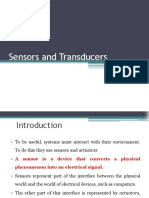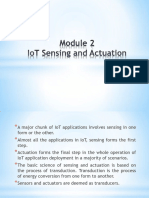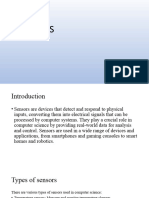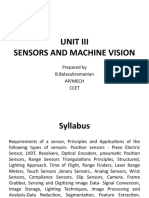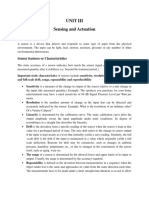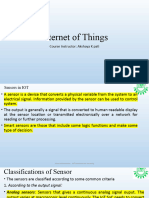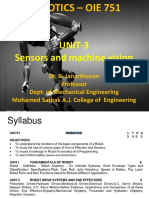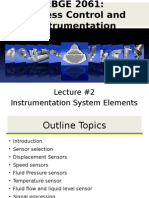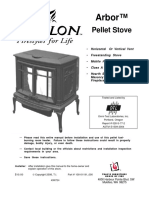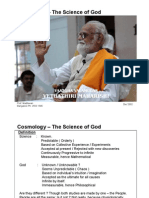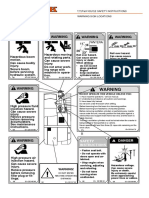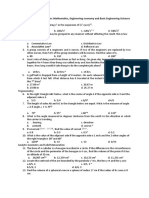0 ratings0% found this document useful (0 votes)
2 viewsMODULE 2 (1)
MODULE 2 (1)
Uploaded by
丂卂Ҝ丂卄卂ㄒ卄iot
Copyright:
© All Rights Reserved
Available Formats
Download as PDF, TXT or read online from Scribd
MODULE 2 (1)
MODULE 2 (1)
Uploaded by
丂卂Ҝ丂卄卂ㄒ卄0 ratings0% found this document useful (0 votes)
2 views35 pagesiot
Copyright
© © All Rights Reserved
Available Formats
PDF, TXT or read online from Scribd
Share this document
Did you find this document useful?
Is this content inappropriate?
iot
Copyright:
© All Rights Reserved
Available Formats
Download as PDF, TXT or read online from Scribd
Download as pdf or txt
0 ratings0% found this document useful (0 votes)
2 views35 pagesMODULE 2 (1)
MODULE 2 (1)
Uploaded by
丂卂Ҝ丂卄卂ㄒ卄iot
Copyright:
© All Rights Reserved
Available Formats
Download as PDF, TXT or read online from Scribd
Download as pdf or txt
You are on page 1of 35
MODULE 2
IoT Sensing and Actuation: Introduction, Sensors, Sensor
Characteristics, Sensorial Deviations, Sensing Types, Sensing
Considerations, Actuators, Actuator Types, Actuator
Characteristics.
Sensors
• A sensor is a device that detects and responds to some type of input from the
physical environment.
• Sensors are devices that can measure, or quantify, or respond to the ambient
changes in their environment or within the intended zone of their
deployment.
Figure: The outline of a simple sensing operation
• The various sensors can be classified based on:
1) Power requirements
2) Sensor output
3) Property to be measured.
• Power Requirements: The way sensors operate decides the power
requirements that must be provided for an IoT implementation.
• Some sensors need to be provided with separate power sources for them to
function, whereas some sensors do not require any power sources.
Depending on the requirements of power, sensors can be of two types.
(i) Active sensors: They do not require an external circuitry or mechanism to
provide it with power.
For example, a photodiode converts light into electrical impulses.
(ii) Passive sensors: They require an external mechanism to power them up.
For example, a thermistor’s resistance can be detected by applying
voltage difference across it or passing a current through it.
• Output: The output of a sensor helps in deciding the additional components
to be integrated with an IoT node or system.
Sensors are broadly divided into two types, depending on the type of output
generated from these sensors
• (i) Analog: Analog sensors generate an output signal or voltage, which is
proportional (linearly or non-linearly) to the quantity being measured and is
continuous in time and amplitude.
• Physical quantities such as temperature, speed, pressure, displacement, strain,
and others are all continuous and categorized as analog quantities.
• For example, a thermometer or a thermocouple can be used for measuring the
temperature of a liquid (e.g., in household water heaters).
(ii) Digital: These sensors generate the output of discrete time digital
representation (time, or amplitude, or both) of a quantity being measured, in the
form of output signals or voltages.
• Typically, binary output signals in the form of a logic 1 or a logic 0 for ON or
OFF, respectively are associated with digital sensors.
• Measured Property: The property of the environment being measured by the
sensors can be crucial in deciding the number of sensors in an IoT
implementation.
• Some properties to be measured do not show high spatial variations and can be
quantified only based on temporal variations in the measured property, such as
ambient temperature, atmospheric pressure, and others.
• Whereas some properties to be measured show high spatial as well as
temporal variations such as sound, image, and others. Depending on the
properties to be measured, sensors can be of two types.
• Scalar: Scalar sensors produce an output proportional to the magnitude of the
quantity being measured. The output is in the form of a signal or voltage.
• Examples of such measurable physical quantities include color, pressure,
temperature, strain, and others.
• A thermometer or thermocouple is an example of a scalar sensor that has the
ability to detect changes in ambient or object temperatures (depending on the
sensor’s configuration).
• Factors such as changes in sensor orientation or direction do not affect these
sensors (typically).
(ii) Vector: Vector sensors are affected by the magnitude as well as the
direction and/or orientation of the property they are measuring.
• Physical quantities such as velocity and images that require additional
information besides their magnitude for completely categorizing a physical
phenomenon are categorized as vector quantities.
• Measuring such quantities are undertaken using vector sensors.
• For example, an electronic gyroscope, which is commonly found in all
modern aircraft, is used for detecting the changes in orientation of the
gyroscope with respect to the Earth’s orientation along all three axes.
• The basic architecture of sensor node consists of composed of four major
parts namely
• Powering Unit
• Sensing Unit
• Processing Unit
• Communication Unit
Figure: The functional blocks of a typical sensor node in IoT
• Sensor Characteristics
• Even within the same sensor type and class, sensors can be characterized by
their ability to sense the phenomenon based on the following three
fundamental properties.
a) Sensor Resolution
b) Sensor Accuracy
c) Sensor Precision
Sensor resolution is the smallest change in a sensor's input that it can detect
and express in its output signal.
Sensor accuracy is the maximum difference between the actual value and the
value indicated by a sensor.
• Sensory Precision: The concept of precision refers to the degree of
reproducibility of a measurement.
• In other words, if exactly the same value were measured a number of times,
an ideal sensor would output exactly the same value every time.
Sensorial Deviations
• Sensorial deviations in IoT refer to the limitations on sensor accuracy that can
occur when sensors are unable to replicate an ideal transfer function.
• These deviations can occur when the measured property exceeds the limits of
the sensor's output signal range, causing the signal to reach its minimum or
maximum.
• Under real conditions, the sensitivity of a sensor may differ from the value
specified for that sensor leading to sensitivity error.
• In contrast, if a sensor’s output varies/deviates due to deviations in the sensor’s
previous input values, it is referred to as hysteresis error.
• If the output of a sensor differs from the actual value to be measured by a
constant, the sensor is said to have an offset error or bias.
• For example, while measuring an actual temperature of 0 ◦ C, a temperature
sensor outputs 1.1 ◦ C every time. In this case, the sensor is said to have an
offset error or bias of 1.1 ◦ C.
Sensing Types
• Sensing can be broadly divided into four different categories based on the
nature of the environment being sensed and the physical sensors being used
to do so.
1) Scalar Sensing
2) Multimedia Sensing
3) Hybrid Sensing
4) Virtual Sensing
Scalar sensing
• Scalar sensing is the use of a sensor to measure a single scalar value, or a
quantity with magnitude but no direction.
• Scalar sensing encompasses the sensing of features that can be quantified
simply by measuring changes in the amplitude of the measured values with
respect to time.
• Quantities such as ambient temperature, current, atmospheric pressure,
rainfall, light, humidity, flux, and others are considered as scalar values.
• Simply measuring the changes in their values with passing time provides
enough information about these quantities.
• The sensors used for measuring these scalar quantities are referred to as
scalar sensors, and the act is known as scalar sensing.
Multimedia sensing
• Multimedia sensing encompasses the sensing of features that have a spatial
variance property associated with the property of temporal variance.
• Unlike scalar sensors, multimedia sensors are used for capturing the changes
in amplitude of a quantifiable property concerning space (spatial) as well as
time (temporal).
• Quantities such as images, direction, flow, speed, acceleration, sound, force,
mass, energy, and momentum have both directions as well as a magnitude.
• The sensors used for measuring these quantities are known as vector sensors.
Camera sensor, Compass and barometer are vector sensors.
Hybrid Sensing
• The act of using scalar as well as multimedia sensing at the same time is
referred to as hybrid sensing.
• Many a time, there is a need to measure certain vector as well as scalar
properties of an environment at the same time.
• Under these conditions, a range of various sensors are employed (from the
collection of scalar as well as multimedia sensors) to measure the various
properties of that environment at any instant of time, and temporally map the
collected information to generate new information.
• Other common examples of hybrid sensing include smart parking systems,
traffic management systems, and others.
Virtual Sensing
Sensing Considerations
• Sensing Range: Fixed k-coverage is a scheduling mechanism that divides a
network's sensors into disjoint sets, where each set fully covers the network's
area.
• Dynamic k-coverage: Dynamic K-Coverage is a concept commonly used in
wireless sensor networks (WSNs) or surveillance systems where a set of
sensor nodes monitor an area or a set of points of interest.
• ii)Accuracy and Precision:
• iii) Energy
• iv) Device Size
Actuators
• An actuator is a device that converts energy into physical motion or action. It
is a key component in systems that require control over physical objects,
such as robotics, industrial machines, or mechanical systems.
• Actuators are the components responsible for moving or controlling a
mechanism or system, typically in response to a signal or command from a
control system
Figure: The outline of a simple actuation mechanism
Actuator Types
• Broadly, actuators can be divided into seven classes:
1) Hydraulic
2) Pneumatic
3) Electrical
4) Thermal/Magnetic
5) Mechanical
6) Soft
7) Shape Memory Polymers.
Hydraulic actuators
• A hydraulic actuator works on the principle of compression and
decompression of fluids.
• These actuators facilitate mechanical tasks such as lifting loads through the
use of hydraulic power derived from fluids in cylinders or fluid motors.
• The mechanical motion applied to a hydraulic actuator is converted to either
linear, rotary, or oscillatory motion.
Pneumatic actuators
• A pneumatic actuator works on the principle of compression and
decompression of gases.
• These actuators use a vacuum or compressed air at high pressure and
convert it into either linear or rotary motion.
• Pneumatic actuators are responsible for converting pressure into force.
Electric actuators
• Typically, electric motors are used to power an electric actuator by
generating mechanical torque.
• This generated torque is translated into the motion of a motor’s shaft or for
switching
Thermal or magnetic actuators
• The use of thermal or magnetic energy is used for powering this class of
actuators.
• These actuators have a very high power density and are typically compact,
lightweight, and economical.
• One classic example of thermal actuators is shape memory materials (SMMs)
such as shape memory alloys (SMAs).
• These actuators do not require electricity for actuation. They are not affected
by vibration and can work with liquid or gases.
• Magnetic shape memory alloys (MSMAs) are a type of magnetic actuators.
Mechanical actuators
• In mechanical actuation, the rotary motion of the actuator is converted into
linear motion to execute some movement.
• The use of gears, rails, pulleys, chains, and other devices are necessary for
these actuators to operate.
• These actuators can be easily used in conjunction with pneumatic, hydraulic,
or electrical actuators.
Soft actuators
• A soft actuator is a type of material based on soft matter that converts a
source of energy into motion.
• Soft actuators (e.g., polymer-based) consists of elastomeric polymers that
are used as embedded fixtures in flexible materials such as cloth, paper, fiber,
particles, and others.
Soft Actuators and Soft Robots
• Elastomeric polymers, also known as elastomers, are polymers that have the
property of elasticity, meaning they can deform under an external load and
return to their original shape when the load is removed.
• The conversion of molecular level microscopic changes into tangible
macroscopic deformations is the primary working principle of this class of
actuators.
• These actuators have a high stake in modern-day robotics.
• They are designed to handle fragile objects such as agricultural fruit
harvesting, or performing precise operations like manipulating the internal
organs during robot-assisted surgeries.
Shape memory polymers
• Shape memory polymers (SMP) are considered as smart materials that
respond to some external stimulus by changing their shape, and then revert to
their original shape once the affecting stimulus is removed.
• Photopolymer/light-activated polymers (LAP) are a particular type of SMP,
which require light as a stimulus to operate.
• The polymer retains its shape after removal of the activating light. In order to
change the polymer back to its original shape, a light stimulus of a different
frequency has to be applied to the polymer.
Actuator Characteristics
• Weight: The use of heavier actuators is generally preferred for industrial
applications and applications requiring no mobility of the IoT deployment.
• In contrast, lightweight actuators typically find common usage in portable
systems in vehicles, drones, and home IoT applications.
• Heavier actuators also have selective usage in mobile systems, for example,
landing gears and engine motors in aircraft.
• Power Rating: The power rating defines the minimum and maximum
operating power an actuator can safely withstand without damage to itself.
Generally, it is indicated as the power-to-weight ratio for actuators.
• The power rating of an actuator is the maximum amount of power it can
deliver over a long period of time.
• Torque to Weight Ratio: The ratio of torque to the weight of the moving part
of an instrument/device is referred to as its torque/weight ratio.
• This indicates the sensitivity of the actuator. Higher is the weight of the
moving part; lower will be its torque to weight ratio for a given power.
Stiffness and Compliance
• The resistance of a material against deformation is known as its stiffness,
whereas compliance of a material is the opposite of stiffness.
• A measure of how much a material or structure moves when a force is
applied. A material with high compliance will displace significantly when a
load is applied.
• Stiffness can be directly related to the modulus of elasticity of that material.
• Stiff systems are considered more accurate than compliant systems as they
have a faster response to the change in load applied to it.
• For example, hydraulic systems are considered as stiff and non-compliant,
whereas pneumatic systems are considered as compliant.
Thank you!!!
You might also like
- Crown SP 3500 Stock Picker Lift Truck Operator's Manual PDFDocument22 pagesCrown SP 3500 Stock Picker Lift Truck Operator's Manual PDFVüsal 1No ratings yet
- MechatronicsDocument61 pagesMechatronicsSajitha ManuNo ratings yet
- Industrial InstrumentationDocument74 pagesIndustrial InstrumentationAjish AJ100% (3)
- IoT Sensing and Actuation - M2 - CompleteDocument59 pagesIoT Sensing and Actuation - M2 - Completesntsjnts7No ratings yet
- Module 2Document32 pagesModule 2rakshtha.ramesh32No ratings yet
- Internet of Things 2Document54 pagesInternet of Things 2R G SakthivelanNo ratings yet
- Iot Module 2Document12 pagesIot Module 2nagaraj pNo ratings yet
- MODULE 2 - IoT-1Document45 pagesMODULE 2 - IoT-1jeevankusuma12No ratings yet
- 22 Sensors IntroductionDocument13 pages22 Sensors IntroductionManeet BhasinNo ratings yet
- Sensors and Data Acquisition: Radar GunDocument91 pagesSensors and Data Acquisition: Radar GunBurak Bildirici100% (1)
- Internet of Things BETCK105H - Module - 2Document53 pagesInternet of Things BETCK105H - Module - 2Chandrashekhar BannikoduNo ratings yet
- Sensors PPT NotesDocument23 pagesSensors PPT NotesUday sonwaneNo ratings yet
- 07-Intro To SensorsDocument27 pages07-Intro To SensorsRemo Rubian EvangelistaNo ratings yet
- 2.sensors and TransducersDocument100 pages2.sensors and TransducersKelvin RaoNo ratings yet
- IoT Module 2 IoT Sensing and ActuationDocument25 pagesIoT Module 2 IoT Sensing and Actuationabhishek.ecNo ratings yet
- C8: Sensor and Sensor TechnologyDocument72 pagesC8: Sensor and Sensor TechnologyOladokun Sulaiman Olanrewaju100% (4)
- SensorsDocument20 pagesSensorsaadit1.sirohiyaNo ratings yet
- Review of Transducer and SensorDocument113 pagesReview of Transducer and SensorSyedZameerNo ratings yet
- Sensors in Internet of ThingsDocument5 pagesSensors in Internet of ThingsAnkshu RayNo ratings yet
- E-Note 5596 Content Document 20231104101220PMDocument16 pagesE-Note 5596 Content Document 20231104101220PMdigitalpixelpalleteNo ratings yet
- L - 5 Sensors and Transforms by Arpita MemDocument31 pagesL - 5 Sensors and Transforms by Arpita MemAbul Hasan 2No ratings yet
- U1-Intraduction To Sensors and TransducersDocument74 pagesU1-Intraduction To Sensors and TransducersVibishiniya VNo ratings yet
- Sensors, Actuators & Smart ObjectsDocument20 pagesSensors, Actuators & Smart Objectsmaitynabanita01No ratings yet
- Sensors and Transducers Real Time Computing and Programming - SensorsDocument80 pagesSensors and Transducers Real Time Computing and Programming - SensorsNon ArtistsNo ratings yet
- Intro 32Document252 pagesIntro 32ANTONo ratings yet
- Unit Iii Sensors and Machine Vision: Prepared by B.Balasubramanian Ap/Mech CcetDocument66 pagesUnit Iii Sensors and Machine Vision: Prepared by B.Balasubramanian Ap/Mech CcetBala mechNo ratings yet
- iot module 2 pptxDocument52 pagesiot module 2 pptxsannsanam13No ratings yet
- Unit IiiDocument11 pagesUnit IiiCbitpavan ReddyNo ratings yet
- Module-2 IOTDocument104 pagesModule-2 IOTankita81123singhNo ratings yet
- Unit 1 - ASVDocument24 pagesUnit 1 - ASVAnup S. Vibhute DITNo ratings yet
- chapter_1 instrumentionDocument64 pageschapter_1 instrumentionTirumarNo ratings yet
- Ee8403 Measurement and Instrumentation Unit 1Document58 pagesEe8403 Measurement and Instrumentation Unit 1Arunkumar NambirajuNo ratings yet
- Topic:: Sensor TechnologyDocument15 pagesTopic:: Sensor TechnologyPooja koreNo ratings yet
- MOdule 2 - GivenDocument58 pagesMOdule 2 - Givensreeni 1005No ratings yet
- Chapter 1Document40 pagesChapter 1Dagem GetachewNo ratings yet
- Lecture 10Document35 pagesLecture 10Shikhar VijeetNo ratings yet
- Module 2Document61 pagesModule 2yashpalsingh80726No ratings yet
- Robotics Unit3 SensorsDocument120 pagesRobotics Unit3 SensorsJanarthanan BalakrishnasamyNo ratings yet
- Sensors and TransducersDocument118 pagesSensors and TransducersDhaval Patel100% (2)
- Ahmed A Iot2Document24 pagesAhmed A Iot2Kavita KamerikarNo ratings yet
- Lecture #2 (Instrumentation System Elements) v1Document84 pagesLecture #2 (Instrumentation System Elements) v1Salina MohmadNo ratings yet
- IoT Unit-IDocument144 pagesIoT Unit-IADITYA SACHIN NEVENo ratings yet
- BETCK105H-IOT Module-2Document15 pagesBETCK105H-IOT Module-2Sandeep K HNo ratings yet
- MI - Unit 1 - CLASS NOTESDocument74 pagesMI - Unit 1 - CLASS NOTESvbarath58No ratings yet
- Measurement and Sensors - Lecture1Document17 pagesMeasurement and Sensors - Lecture1Atharva Soni100% (1)
- Lecture #1 (Measurement Systems)Document56 pagesLecture #1 (Measurement Systems)inabalqisNo ratings yet
- 21CS735 - Module-2 NotesDocument13 pages21CS735 - Module-2 Notes29r8zkh6p2No ratings yet
- Chapter-5 Module 2-IoT For Ist SemDocument48 pagesChapter-5 Module 2-IoT For Ist SemNeha nayak100% (3)
- Unit - 1: Science of MeasurementDocument29 pagesUnit - 1: Science of MeasurementBlakheart TysonNo ratings yet
- TransducersDocument61 pagesTransducersAryan jay vermaNo ratings yet
- MCE 409 Sensors and Actuators Note 2Document28 pagesMCE 409 Sensors and Actuators Note 2Yohane JosephNo ratings yet
- Sensorandtransducerslect1 160623152141Document80 pagesSensorandtransducerslect1 160623152141pushpanarayanan100% (1)
- Module 2 IoTDocument11 pagesModule 2 IoTK Goutam XII 'D'No ratings yet
- PDF UNIT - 2 Sensors & Transducers 2024batchDocument113 pagesPDF UNIT - 2 Sensors & Transducers 2024batchEkta Arts&designNo ratings yet
- Introduction To Sensors and Actuators: S. Senthil RajaDocument38 pagesIntroduction To Sensors and Actuators: S. Senthil RajassrgmanNo ratings yet
- Robotics SensorsDocument13 pagesRobotics SensorsVishal ParmarNo ratings yet
- Module 2Document72 pagesModule 2Preethi M SNo ratings yet
- Robotics Unit-5Document64 pagesRobotics Unit-5S19IT1215 HarshithaNo ratings yet
- University of Technology: Mechanical Engineering DepartmentDocument20 pagesUniversity of Technology: Mechanical Engineering DepartmentMohammed SalmanNo ratings yet
- Sensors A Comprehensive GuideDocument10 pagesSensors A Comprehensive Guidemanoj NNo ratings yet
- Handbook of Mechanical and Materials EngineeringFrom EverandHandbook of Mechanical and Materials EngineeringRating: 5 out of 5 stars5/5 (4)
- Water Supply NotesDocument13 pagesWater Supply NotesVenkat RamanNo ratings yet
- Lesson 9.1 Apt Adp CycleDocument22 pagesLesson 9.1 Apt Adp CycleClarence Sanchez AntoninoNo ratings yet
- ACS Review 2 AlkanesDocument9 pagesACS Review 2 AlkanesZeniaNo ratings yet
- ThesisDocument23 pagesThesisZabeehullahmiakhailNo ratings yet
- Fluiten Plan APIDocument71 pagesFluiten Plan APImontsegran100% (1)
- 4 EMD Test 2 Sem2!21!22Document5 pages4 EMD Test 2 Sem2!21!22nelissa nazriNo ratings yet
- Acrobat Distiller 4.0 For2008-10-23 14-29-58816Document42 pagesAcrobat Distiller 4.0 For2008-10-23 14-29-58816amijoski6051No ratings yet
- Operation Manual JOAN LABDocument2 pagesOperation Manual JOAN LABDoménica Feijoó ChávezNo ratings yet
- Hot Solar Air ConditionerDocument19 pagesHot Solar Air ConditionerThế Thuận HồNo ratings yet
- Axial Fan Catalog WebDocument12 pagesAxial Fan Catalog WebbassouadNo ratings yet
- Chapter Test B: Chemical ReactionsDocument4 pagesChapter Test B: Chemical ReactionssnowNo ratings yet
- Valuation and Risk Management in Energy Markets Swindle G. 2024 scribd downloadDocument81 pagesValuation and Risk Management in Energy Markets Swindle G. 2024 scribd downloadtonmoynekyar100% (1)
- Methylene (CH2) : C C CCDocument2 pagesMethylene (CH2) : C C CCItachi UchihaNo ratings yet
- 2024-JEE Advanced Booster Test-3 - PaperDocument14 pages2024-JEE Advanced Booster Test-3 - PapervaibhavkhokhaNo ratings yet
- Material Science: Prof. Satish V. KailasDocument7 pagesMaterial Science: Prof. Satish V. KailasHagere EthiopiaNo ratings yet
- Production of Ethylene Glycol From Methanol and Syngas Via Glycolic AcidDocument4 pagesProduction of Ethylene Glycol From Methanol and Syngas Via Glycolic AcidKlea Camille Ganoy BrionesNo ratings yet
- 17-lies-that-are holding you-back کانون زبان جهان 36633872 آدرس:جاده فرد - home - blogfa.com world-language.blogfa.com/tag/Home Translate this page کانون زبان جهان 36633872 آدرس:جاده فرد - home - کانون زبان جهان 36633872 آدرس:جاده فردیس شهرک 110.pdfDocument4 pages17-lies-that-are holding you-back کانون زبان جهان 36633872 آدرس:جاده فرد - home - blogfa.com world-language.blogfa.com/tag/Home Translate this page کانون زبان جهان 36633872 آدرس:جاده فرد - home - کانون زبان جهان 36633872 آدرس:جاده فردیس شهرک 110.pdfmsoofloo100% (1)
- MBR Research ProposalDocument7 pagesMBR Research ProposalAshber Ur Rehman KhanNo ratings yet
- B.35 35 ReportDocument198 pagesB.35 35 ReportAhmed Said GhonimyNo ratings yet
- Fagor Induction HOB PDFDocument45 pagesFagor Induction HOB PDFSk WongNo ratings yet
- Vethathiri - Science of GodDocument16 pagesVethathiri - Science of GodProf. Madhavan100% (3)
- Pantera1100 o 2Document10 pagesPantera1100 o 2Emad Abu SafeihNo ratings yet
- Engine Xinchai 490Document30 pagesEngine Xinchai 490vitor santos100% (3)
- ME 601 Compre Answer KeyDocument12 pagesME 601 Compre Answer KeyMemento MoriNo ratings yet
- Fisher Isotemp Oven Instruction Manual 600 SerieDocument25 pagesFisher Isotemp Oven Instruction Manual 600 SerieAlan Veizaga0% (1)
- Ms For Demin Water Tank Modification Rev 1 Feb. 28 2011lastDocument9 pagesMs For Demin Water Tank Modification Rev 1 Feb. 28 2011lastsharif339100% (1)
- TransformersDocument2 pagesTransformersBinuri SandarekhaNo ratings yet
- Sky & Telescope - May 2013Document90 pagesSky & Telescope - May 2013elmushkaNo ratings yet













